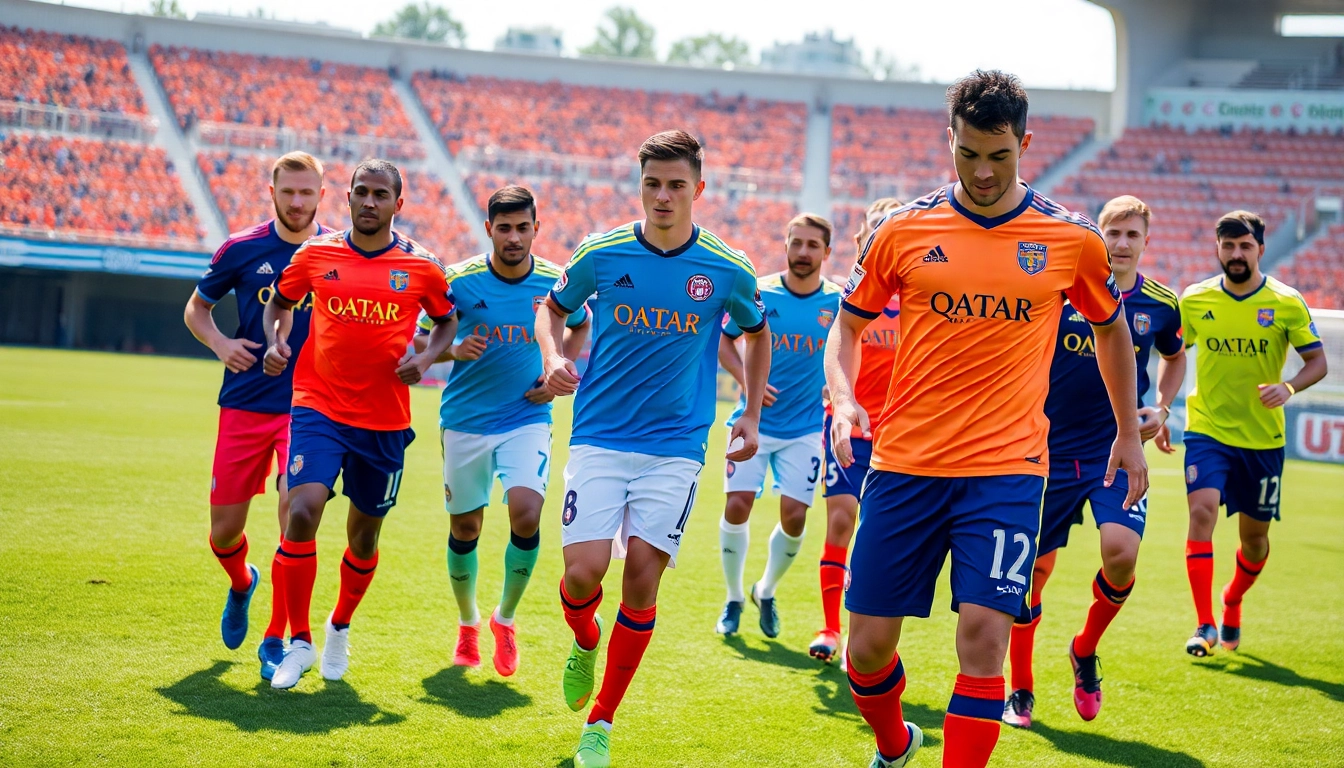Understanding the Essentials of Soccer Uniforms
Soccer uniforms are more than just clothing; they are a vital component of a team’s identity, performance, and cohesion on the field. Designing and choosing the right uniform involves a thorough understanding of the materials, technologies, and design elements that influence comfort, durability, and functionality. Whether for youth leagues, amateur clubs, or professional teams, the ideal soccer uniform must strike a balance between aesthetic appeal and practical performance.
To explore these crucial aspects, it’s beneficial to start with the foundational components of soccer uniforms—material and fabric technologies. High-performance fabrics are engineered to enhance athletic performance while providing comfort and durability. Additionally, deliberate design elements, such as moisture-wicking properties and ergonomic cuts, contribute to player efficiency. Furthermore, uniforms serve as a canvas for branding and team identity, making their visual design equally important to performance features.
For those interested in exploring a variety of apparel options, Soccer Uniforms offer a comprehensive range tailored to different needs, from youth teams to professional clubs.
Material and Fabric Technologies for Comfort
The choice of fabric significantly impacts a soccer uniform’s performance. The most advanced materials employed in soccer apparel are designed to be lightweight, breathable, and moisture-wicking. Technologies such as Dri-FIT, ClimaCool, and ThermoLite are increasingly prevalent, ensuring sweat is rapidly evaporated from the body, keeping players dry and comfortable even during intense matches.
Modern soccer jerseys typically utilize polyester blends that incorporate microfibers, providing excellent breathability and resilience against wear and tear. These fabrics are engineered to stretch and move with the athlete’s body, reducing chafing and enhancing mobility. For example, many Nike and adidas jerseys integrate moisture management systems that channel sweat away from the skin and facilitate rapid drying.
Durability is another critical factor, especially for youth and amateur leagues where uniforms undergo frequent washing and rough handling. Advanced fabric technologies improve lifespan, resist fading, and maintain structural integrity over time.
Design Elements That Enhance Performance
Beyond material selection, thoughtful design elements play a vital role in optimizing player performance. Ergonomically tailored fits prevent jersey movement disruption during gameplay and reduce restrictions, enhancing agility and speed. Athletic cuts, flatlock seams, and strategic paneling are common features that improve comfort and reduce irritation.
Additionally, color schemes and pattern designs are not solely aesthetic—they can influence visibility on the field, camouflage certain positions, or intimidate opponents. For instance, high-contrast patterns improve player visibility for teammates, facilitating quick passes and coordinated movements.
Incorporating lightweight padding or strategic ventilation zones can also improve comfort during high-impact plays and prolonged exertion, making the uniform an active performance enhancer.
Matching Team Identity and Branding
A soccer uniform serves as a vital tool for representing team identity and fostering a sense of unity among players. Customizing uniforms with team logos, colors, and branding elements not only promotes team spirit but also aids in recognition during matches and tournaments.
Most teams opt for personalized elements such as crest logos, sponsor placements, and player names and numbers. These customizations should be integrated seamlessly, utilizing high-quality embroidery or heat-transfer techniques to withstand regular laundering.
Advanced digital printing methods enable complex designs and vibrant color reproductions, giving teams full creative control over their uniforms. This branding extends beyond aesthetics—consistent visual identity can boost team morale and elevate the team’s professional image.
Customizing Soccer Uniforms to Fit Your Team’s Needs
Color Schemes, Logos, and Personalization Options
Customization begins with selecting a color palette that aligns with your team’s identity or club branding. Coordinating colors for jerseys, shorts, and socks creates a cohesive appearance. Logos and sponsor branding are typically added via embroidery or sublimation printing, both offering durability and high-quality finishes.
Personalization options further include player names, numbers, and commemorative symbols, which can be added to reflect team history, achievements, or special events.
Choosing the Right Fit and Sizing for All Players
Proper fit is critical for comfort and performance. Uniforms should be available in a broad range of sizes to accommodate different body types. Customized fitting sessions or size charts help ensure each player receives gear that allows for full mobility without excess material that could hinder movement.
Consider fabric stretch and cut patterns—athletic fits tend to conserve a sleek profile, while relaxed fits might prioritize comfort for younger or less active players.
Order Process and Lead Times for Custom Uniforms
The ordering process typically involves selecting design options, approving mock-ups, and confirming sizes. Lead times vary based on complexity and quantities but generally range from 2 to 6 weeks. Early planning and clear communication with suppliers can prevent delays for tournaments or season starts.
Reliable manufacturers provide detailed timelines and offer sample approvals to ensure expectations align before mass production.
Best Practices for Maintaining Soccer Uniforms
Cleaning Tips to Preserve Fabric and Colors
Proper maintenance preserves the appearance and functionality of soccer uniforms. Washing uniforms inside out in cold water minimizes color fading and fabric deterioration. Avoiding harsh detergents and bleach prolongs the lifespan of vibrant colors and logos. Using mild detergents specifically formulated for sports apparel is recommended.
Storage Solutions for Longevity
Store uniforms in a cool, dry place away from direct sunlight to prevent fading and fabric breakdown. Hanging jerseys on padded hangers helps maintain shape, while folded storage is suitable for off-season periods. Ensuring uniforms are thoroughly dry before storing prevents mold and mildew growth.
Replacing and Upgrading Your Uniforms Over Time
Regular evaluation of uniforms is necessary to identify wear and tear. Upgrading or replacing gear prevents discomfort and maintains team image. Modern advances in fabric technology often warrant new purchases every 2-3 seasons, depending on usage frequency.
Cost Considerations and Budget Planning
Affordable Options for Youth and Amateur Teams
Budget-friendly uniforms often feature simpler designs and basic fabrics focusing on durability rather than high-tech performance materials. Manufacturers offering bulk discounts and standardized sizing options make it easier for youth and amateur teams to outfit their players without overspending.
Premium Uniforms for Competitive and Professional Play
High-end uniforms incorporate advanced fabrics, custom fits, and detailed branding. They often come from reputable brands like Nike, Adidas, or specialized manufacturers such as Xara Soccer, providing enhanced performance benefits suitable for elite athletes.
Bulk Orders and Discounts for Teams and Organizations
Ordering in bulk frequently results in substantial savings. Many suppliers offer tiered pricing, free setup for logos, and fast turnaround for large orders. Planning ahead and consolidating orders can optimize costs and ensure timely delivery.
Top Brands and Manufacturers in Soccer Uniforms
Leading Brands Offering High-Performance Jerseys
Recognized global brands such as Nike, Adidas, and Puma set industry standards with innovative designs and reliable quality. These brands frequently collaborate with professional teams, offering cutting-edge technology integrated into their apparel.
Emerging Trends and Innovations in Soccer Apparel
Trends include eco-friendly fabrics, smart textiles with embedded sensors, and customizable, digitally printed designs that allow for rapid prototype development. Innovations also focus on improving moisture-wicking and temperature regulation, vital for player stamina.
How to Choose a Reliable Supplier for Your Team
Reliable suppliers demonstrate quality craftsmanship, flexible customization options, transparent lead times, and excellent customer service. Reading reviews, requesting samples, and verifying past client testimonials are crucial steps in selecting a trustworthy partner.



